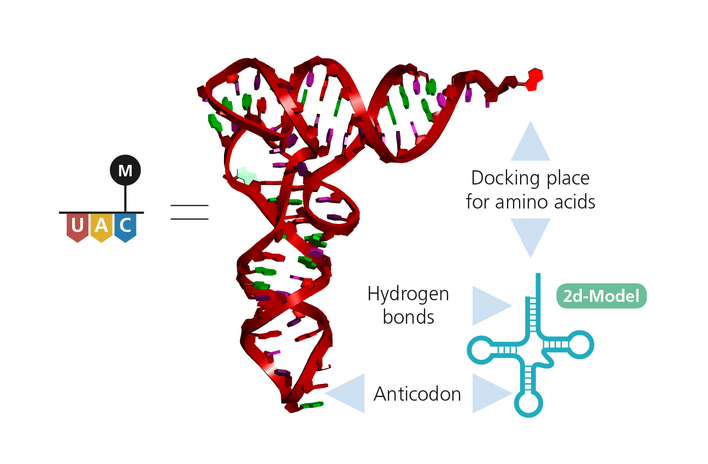A protein consists of a long chain of interconnected amino acids. The information, which amino acids have to be linked in which order, is stored on the genes in a sequence of so-called triplet codes (codons). Each codon consists of three nucleobases and codes for one of the 20 existing amino acids. The four different nucleobases (A, G, C, U) can be combined to 4 x 4 x 4=64 different codons. 61 of these codons encode for the 20 amino acids and 3 codons are so-called stop codons. The latter serve as stop signs and terminate the synthesis of the protein molecule. For many of the 20 amino acids several different codings exist. The code is "redundant".
Transfer RNAs (tRNAs) are the messengers of the respective amino acids according to the triplet code. On one side of the tRNA the anticodon recognizes the codon on the mRNA and binds to it. On the other side, the corresponding amino acid is coupled and is transferred from by ribosome to the growing polypeptide chain. The free tRNA is then released and frees up the space for a newly arriving tRNA. The ribosome glides step by step over the mRNA.
The mRNA is read by a ribosome. Normally the protein synthesis starts at an AUG codon. The corresponding amino acid, methionine, is brought to the ribosome via a tRNA. The protein is then built up by adding amino acid after amino acid to form a long chain, while the ribosome glides over the mRNA in 3 nucleotide steps.
[Translate to english:]
Einleitung/Initiation: Das Ribosom, eine riesige Maschinerie in der Zelle, erkennt die mRNA, die aus dem Zellkern ins Zytoplasma transportiert wurde. Das Ribosom dockt an eines der Enden der mRNA an (dem sogenannten 5’-Ende) und sucht die darauffolgende Sequenz nach dem Startcodon "AUG" ab. Hat das Ribosom eine "AUG"-Sequenz in der mRNA gefunden, beginnt die Proteinsynthese mit der passenden, AUG-erkennenden tRNA. tRNAs überbringen die jeweilige Aminosäure gemäss dem Triplettcode. Auf der einen Seite der tRNA befindet sich die sogenannte “Anticodon”-Sequenz, welche das Codon auf der mRNA erkennt und daran bindet. Auf der anderen Seite ist die zugehörige Aminosäure gekoppelt, welche vom Ribosom auf die wachsende Polypeptidkette übertragen wird. Ist die Nukleotidsequenz des Anticodons der tRNA komplementär zur Codonsequenz in der mRNA, kann die tRNA nach dem Schlüssel-Schloss-Prinzip binden – zwischen dem "AUG" Startcodon und der Initiator-tRNA entsteht ein sogenannter Initiationskomplex. Da "AUG" für die Aminosäure Methionin kodiert, ist die Initiator-tRNA immer mit einem Methionin beladen und jedes neu hergestellte Protein beginnt mit dieser Aminosäure.
Verlängerung/Elongation: Hat sich ein Initiationskomplex gebildet, wird die Sequenz des folgenden Codons untersucht. Bindet die nach dem Anticodon-Codon-Prinzip passende tRNA, wird die vorherige Aminosäure (in unserem Beispiel das Methionin von der Initiation) auf die Aminosäure der neuen tRNA übertragen und man erhält eine Kette von zwei Aminosäuren auf der neuen tRNA - es hat also eine “Elongation” (Verlängerung) stattgefunden. In folgenden Elongationsschritten wird jetzt ein Codon nach dem anderen abgelesen, von der richtigen tRNA erkannt, und die Aminosäurekette schrittweise auf die jeweils neu eintreffende tRNA übertragen und so verlängert. Dabei liest das Ribosom die gesamte mRNA im Drei-Nukleotid-Raster Schritt für Schritt ab. Die Aminosäuren werden so nach und nach verknüpft und eine Aminosäurenkette entsteht.
Termination: Der Prozess der Elongation geht so lange weiter, bis das Ribosom auf ein Stoppcodon mit der Sequenz "UAA", "UAG" oder "UGA" trifft. In diesem Fall wird die Codonerkennung nicht durch eine tRNA durchgeführt, sondern es gibt spezielle Proteine, die dem Ribosom übermitteln, dass die Proteinherstellung beendet werden soll. Die Aminosäurekette – d.h. das nun fertiggestellte Protein – wird von seiner letzten tRNA-Verankerung abgelöst und vom Ribosom freigelassen. Es kann nun seiner Funktion in der Zelle nachgehen.



